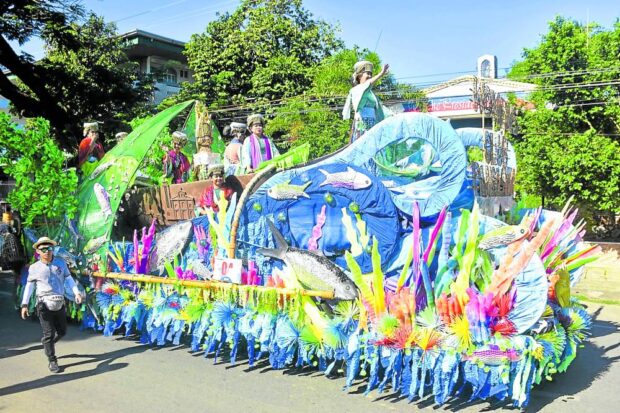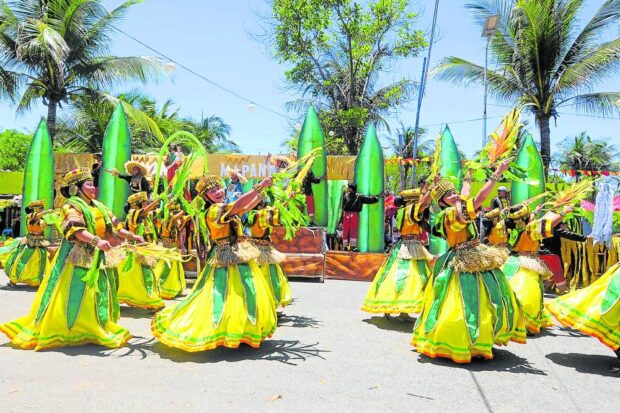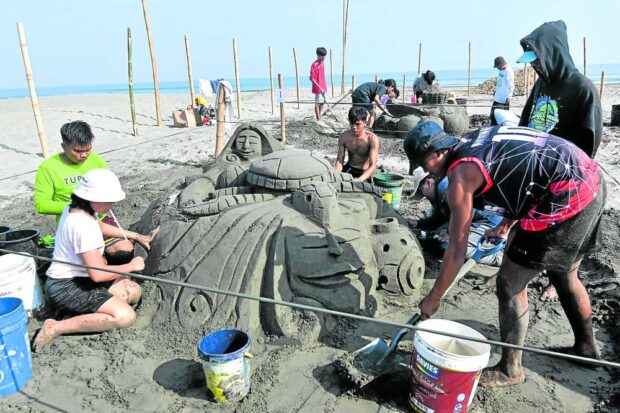Pangasinan folk thank the sea through Pista’y Dayat

FESTIVE MOOD | The float of the Women’s Club of Pangasinan, adjudged champion, is among the 28 colorful floats that joined the parade on May 1, 2023, as part of Pangasinan’s Pista’y Dayat (Sea Festival) celebration. (Photo by WILLIE LOMIBAO / Inquirer Northern Luzon)
LINGAYEN, Pangasinan, Philippines — It was particularly warm and breezy in April when Pangasinenses once again paid homage to the Lingayen Gulf, one of Pangasinan’s economic backbones, by holding the annual Pista’y Dayat (sea festival).
Elders in the province believed the festival had its roots in the 1960s when they would get together and celebrate every first of May.
Fisherfolk from coastal villages in the historic capital town of Lingayen would frolic on local beaches as a form of thanksgiving for the sea’s bounty. And then they would dip in the seawater which, as the belief goes, could heal ailments of all sorts only on that particular day.
Local historian Melchor Orpilla said the early days of the festival had a connection with the Mayflower Festival, with elderly villagers of Lingayen and Alaminos (then still a town) bringing an image of the Virgin Mary for a procession along the beaches.
Dagupan City adopted the village-based activity and coined the name Pista’y Dayat, staging formal activities in 1968, according to the Dagupan City website.
Two years later, the provincial government embraced the sea festival with its own set of tourism, cultural and other events.
Pista’y Dayat had evolved into a monthlong event celebrated in the province—with Pangasinenses and their kin and friends from out of town still trooping to local beaches for the annual summer rendezvous.
But the center of the festival’s celebrations was still Lingayen, where the provincial government lined up activities from morning until night almost daily from April 1 until May 1.
This year’s revelry, which returned after three years due to the COVID-19 pandemic, officially started on April 3 with the opening of the Pangasinan tourism and trade expo at the Lingayen beach front.

On May 1, 2023. it was the turn of street dancers, like the group from Mapandan town, to perform at the Lingayen beachfront. (Photo by WILLIE LOMIBAO / Inquirer Northern Luzon)
Scaled down
Activities were scaled down since it was the start of Holy Week, with organizers opting to stage a simple street-dancing parade and a float featuring a fishing boat from the provincial capitol to the Lingayen beach.
Gov. Ramon Guico III and Vice Gov. Mark Lambino led the occasion with the symbolic lighting of a makeshift “parola” (lighthouse), to signal the opening of the tourism-trade expo where participating towns showcased their unique products and produce.
But after the Holy Week, the festivities went full blast, notwithstanding the extreme heat index during the day and the threat of a downpour at night. The beaches and the capitol grounds were full of people enjoying the shows every day.
Maritess Espiritu, 42, and her children, Pielle Ashley, 16, and Marhione Dale, 12, traveled from Metro Manila to Lingayen early on April 16.
They were eager to see the sand sculptures on the beach that competed during one of the major activities of the festival.
Contestants in the sand sculpting competition endured the unforgiving heat to come up with their masterpieces.
The family also watched “Takayan na Dayew,” a singing competition, that night and was thrilled to see people putting up tents or just sitting in the grassy areas, some with babies, while enjoying the show.
There was also no problem looking for food, as there was a stretch of stalls selling a variety of foods.
“It was just looking for a place to stay that proved challenging as we did not have previous bookings. The hotels and resorts were full. It was good that we were able to find a room near the beach,” Espiritu shared.
The celebration also featured a series of sports events involving 35 teams that participated in cornhole, pentangle, dodgeball, beach handball, beach basketball, beach floorball, karatedo, beach football, beach touch rugby and beach volleyball.
The festival did not only dish out pure entertainment; it also dug deep into the province’s cultural norms and practices, local cuisine and artisanal industries, native games, songs and dances. These were packaged into mini-events and presented during the festival.
For instance, there’s the “Ponsiya,” a culinary contest inspired by the Pangasinan word for “food party.”
“We have food and heirloom recipes to promote and preserve. We also have culinary talents that we can help promote,” Guico said.
The culinary contestants prepared three sets of dishes: a seafood-based appetizer or soup, a meat-based main dish and a dessert.
During the Ponsiya, chefs of restaurants from Pangasinan presented their “homemade dishes with twists,” using the usual food found in the province like the “pinakbet,” Alaminos “longganisa” and “patopat.”
According to the governor, Pangasinan does not only produce delectable “bangus” (milkfish), but also “malaga” (siganid), commonly known as rabbitfish.
Another cultural event of the Pista’y Dayat was the Ipatawir Pangasinan Artisanal Fair held on Maramba Boulevard. The three-day affair provided a platform for local artisans, artists, and young and emerging entrepreneurs to sell their crafts and products—handwoven baskets, beautifully crafted textiles, crocheted items and products from corn husks and rattan.
Dr. Perla Legaspi, head of the Center for Pangasinan Studies, said the artisans understood the value of creating something with their own hands.
“It’s a labor of love that requires patience, skill and deep passion for your chosen craft. We are proud to share them not only with fellow Pangasinenses but to the world,” she said.
She added: “This fair is not just about showcasing our products. It is also about creating a sense of community. We come together to celebrate our shared love of artistry and to support each other in our creative endeavors.”

A week earlier, the 25 candidates of Limgas na Pangasinan channeled the iconic Princess Urduja during the pageant’s cultural costume and talent night at Sison Auditorium. (Photo by WILLIE LOMIBAO / Inquirer Northern Luzon)
Pageant
The celebration also included the traditional pageant, “Limgas na Pangasinan” (Miss Pangasinan), which was originally called “Limgas na Dayat” (Beauty of the Sea) in the festival’s early years.
Charged with the staging of Limgas na Pangasinan was the governor’s wife, Maan, who asked each of the 44 towns and four cities in the province to send a candidate to the pageant.
The top winners, who were crowned on April 30, will be sent and supported by the provincial government to three top national pageants—Limgas na Pangasinan-World Nikhisah Buenafe Cheveh of Binmaley town, Limgas na Pangasinan-Grand Rona Lalaine Lopez of Mangaldan town, and Limgas na Pangasinan-Mutya/Tourism Stacey de Ocampo of Bolinao town.
The beauty queens were introduced to Pangsinenses on May 1 during the float parade competition around the capitol compound.
But where is the sea, the original reason for the festival’s existence, in the celebrations?
Aside from the beach games, sand sculpting and coastal cleanup, the sea seemed to have taken a backseat.
Even Guico was aware of this, but noted that while provincial officials wanted to consider staging a fluvial parade to highlight the gulf’s importance to the lives of Pangasinenses, they were unprepared to mount the event.
“We do not have a dock, we lack rescue boats, equipment and personnel. It will take more resources to hold a fluvial parade,” he said.
While Guico described the recent festival as “well-organized,” he said that provincial officials would work hard to encourage more towns to participate in the next staging of Pista’y Dayat so that the event could draw attention from more local and foreign tourists.

Photo shows residents enjoying the sandsculpting competition, also one of the festival’s
most-awaited events. (Photo by WILLIE LOMIBAO / Inquirer Northern Luzon)
Source of livelihood
Eight towns and two cities of Pangasinan face the Lingayen Gulf—Anda, Bolinao, Bani, Alaminos City, Sual, Labrador, Lingayen, Binmaley, Dagupan City and San Fabian.
Records from the Bureau of Fisheries and Aquatic Resources showed that there are more than 62,000 registered fisherfolk from Pangasinan who are dependent on the Lingayen Gulf for livelihood, as of December 2022.
Last year, municipal fisheries, or the catch by fishermen from municipal waters, contributed 12,000 metric tons (MT) of fish, while commercial fisheries contributed 4 MT.
Aquaculture on the other hand (ponds which are fed by water from the gulf or rivers) and cages, produced 154 MT.
Aside from fishery, the Lingayen Gulf is also vital for tourism, with the Hundred Islands National Park in Alaminos City in its bosom, and the fine beaches of every town, including the widely-known Tondaligan in Dagupan City.